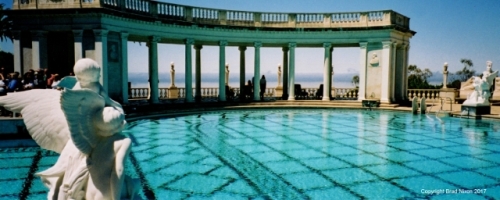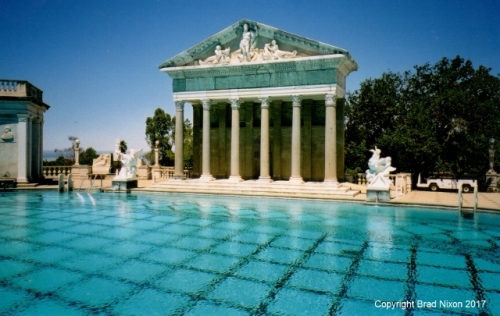One of life’s great pleasures (for those of us whose wealth IS limited) is imagining what we’d do if we actually had inexhaustible wealth.
Clearly, one of the first things to do (once your turn comes) is build one or more palaces of staggering grandeur. There’s a proud tradition of doing so, stretching back into the mists of prehistory.
William Randolph Hearst certainly got the message and took action on a gargantuan scale.
Born to wealth in 1863, Hearst fulfilled his role as a scion of privilege and was booted out of Harvard. Casting about for something to do, he turned his attention to The San Francisco Examiner. His millionaire father owned the newspaper courtesy of payment of a gambling debt (obviously playing for higher stakes than most of us are accustomed to). The young Hearst took hold of it and made it enormously successful. Writers who worked for the Examiner included Ambrose Bierce, Mark Twain and Jack London.
If you don’t know the Hearst story, it’s worth reading about. From his success with the Examiner, he attacked the New York City market, going on to build a news and magazine empire that boasted 20 million readers a day in the 1930s. He fostered a hyperbolic style of journalism that not only sold papers, but influenced politics and social issues.
The enterprise made him fabulously rich, and he knew how to spend it.
In 1915 he decided he was weary of camping in tents during visits to the Hearst family ranch at San Simeon on the central California coast. He engaged the American architect, Julia Morgan, to design a bungalow.
Hearst started tinkering with the idea and the project expanded. The story of how that ranch retreat’s evolution from a bungalow to something rather more extensive is a fascinating tale of hubris and excess.

An obsessive collector of art and artifacts, Hearst had warehouses filled with all manner of stuff. The more he and Morgan worked together, the more grandiose and eccentric grew the scope and scale of the hilltop abode, which Hearst named La Cuesta Encantada, “Enchanted Hill.”

Nice view, eh?
After nearly 30 years, the place still wasn’t complete, because Hearst kept generating new ideas for incorporating not only his vast collection of art and books, but entire rooms, ceilings and facades of ancient and antique castles, estates and churches he bought whole and had shipped to California.

Generally described as a variety of Spanish Baroque, Hearst Castle — as it’s commonly known — simply defies any brief summary: 56 bedrooms, 61 bathrooms, 19 sitting rooms, 127 acres of gardens, indoor and outdoor swimming pools (more on those), tennis courts, a movie theater, an airfield and the world’s largest private zoo.
Here, one of several guest houses on the estate:

The place was the scene of lavish entertainment, attracting an A-list Who’s-Who of the day: Charlie Chaplin, Cary Grant, the Marx Brothers, Charles Lindbergh, Greta Garbo, Joan Crawford, Clark Gable, James Stewart, Bob Hope, Calvin Coolidge, Franklin Roosevelt and Winston Churchill.

When you tour, you’ll see a vast kitchen, a library to die for, endless salons and bedrooms. Although Hearst sold off much of his collection to meet his debts, there’s still a mind-boggling array of paintings, furniture, statuary and books on display. Here’s a description from regular UWS reader La Boheme:
Hearst loved Spain, and especially Spanish art. I would note that U.S. museums generally don’t have much in the way of Spanish art collections. If you’d like to learn more about Spanish art and architecture, you can find plenty here. The range of art in this estate is amazing: antiquities, medieval tapestries, Renaissance furniture, 19th C. sculpture, decorative arts, and more.
As for those swimming pools:

The outdoor one, the Neptune Pool, is, as the name suggests, evokes the excesses of the Roman Empire.
It holds 345,000 gallons of water. Or, rather, it did. A combination of California’s drought conditions and problems with leaks mean that it isn’t currently filled. My photos were taken a dozen years ago, when we pretended there was plenty of water in California.

The shot above shows the facade of an actual Roman temple Hearst — never satisfied with imitations — acquired and shipped from Europe to the site.
The indoor pool is just as impressive (click on these for full sized images).
In the end, Hearst’s wealth was not in fact inexhaustible, and he was a poor manager. Most of his assets had to be liquidated in the late 1930s. As his fortune and health failed in the 1940s, the Hearst family found it prudent to donate the expensive-to-maintain property to the state of California, and it is now a state park, as well as a National Historic Landmark.

That’s good news, because La Cuesta Encantada is no longer solely the domain of the privileged. It’s open for tours. There are several different tours (some, not all, are wheelchair/assistance-accessible), and it requires more than a full day to see all of the castle that’s open to the public. Click here for tour information.
The site is halfway between Los Angeles and San Francisco, between 4 and 6 hours driving time from either city along U.S. 101. Click here for directions on the California State Parks website. The drive itself is memorable for long stretches, along the Pacific coast. Near the castle you may be able to see the enormous elephant seals

The males (bulls) can exceed 16 feet in length and weigh more than 6,500 pounds.
In short, if your travel plans offer an opportunity to drive along the central California coast, do plan to allow time to tour Hearst Castle. The entire coast is worth exploring, in addition to some of the nearby towns like San Luis Obisbo, but at least stop to see Mr. Hearst and Ms. Morgan’s vast creation.
P.S. I regret that I have no interior photos for you. Our visit was in pre-digital camera days, and we didn’t exercise ourselves to essay the exposure and depth of field challenges. The interior is breathtakingly impressive, and will absorb all the attention you can devote to it.
Have you been to Hearst Castle? What struck you in particular? Which tour did you prefer? Leave a comment.
© Brad Nixon 2017. Thanks to La Boheme for the art observations.
I described a building designed by Julia Morgan in nearby San Luis Obispo in this post.


Fantastic place, wonderful post. I love that we have such an amazing piece of history preserved here in California. Also enjoyed learning that it was designed by a female architect, I hadn’t realized that.
LikeLike
By: Stacy di Anna Pollard on January 5, 2017
at 6:05 am
Ms. Morgan did some remarkable work. Most is in the Bay Area, and I’ve seen some. There are Morgan structures here un LA and I plan to write about them eventually. Thank you.
LikeLiked by 1 person
By: Brad Nixon on January 5, 2017
at 6:41 am
Reblogged this on Journal Edge.
LikeLike
By: Vikas Acharya on March 5, 2017
at 11:39 pm
Vikas, many thanks! I’m on a deadline here, but will follow up asap. Best regards!
LikeLike
By: Brad Nixon on March 6, 2017
at 12:07 am
My pleasure Sir 🙂
LikeLiked by 1 person
By: Vikas Acharya on March 6, 2017
at 4:49 am